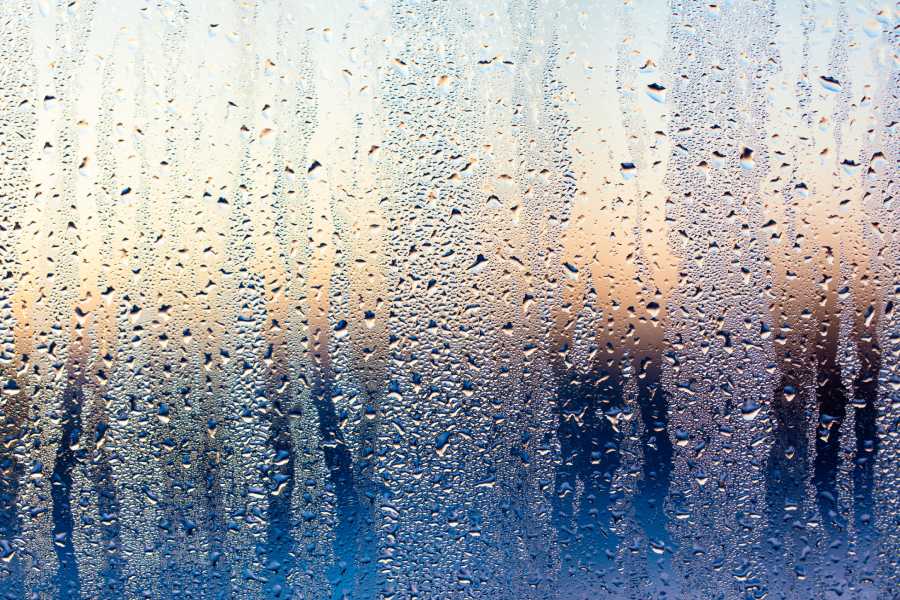Indoor moisture is caused by a variety of factors, including cooking, showering, running dishwashers, storing firewood, pets, fish tanks, plants, clothes, dryers that are not vented properly, even breathing. New windows are more likely to show condensation than old windows because they are airtight – less air is entering your home from the outside. The air leaking from older windows evaporated the moisture before it could collect.
While some humidity is necessary for health and comfort, chronic and excessive condensation should be tipping you off to take some action before serious, costly damage such as decay, mold, paint problems, and even major structural damage occur.
Where is the condensation?
Exterior:
If it is exterior that is usually a good sign, often occurring during the summer months. If there is high humidity, a clear night sky or no wind it can cause exterior condensation. It shows that the house is keeping out the heat and retaining a cool temperature inside.
Interior:
If it is in the interior it means the humidity is high in the house. If the humidity is high then there is a lot of moisture in the air and it is perfectly normal for it to condense on windows, mirrors and other cooler surfaces. IT usually forms in the winter, especially at the beginning of the heating season. As the outside temperature drops, the inside surface will also get cooler; therefore, condensation will form at lower relative humidity on cold days. The colder the air outside, the more likely condensation is to occur. The homeowner has a great deal of control over interior condensation – see the cause/cure section.
Between the Glass:
This means there has been a seal failure. This is rare, however in this instance we would need to re-order and switch out the IGU.
You may notice condensation appearing at the bottom of the window – this is because each insulated unit is a sealed atmosphere, and the air in this atmosphere is layered, just as in any closed space. Warm air rises, and since humidity is attracted to cooler air, condensation will often show near the bottom of the glass.
Temporary Condensation
There are several ways to tell if the condensation on your windows is temporary. Does condensation usually form:
- During baths and showers, cooking, dishwashing, laundry, or other steam producing occasions?
- During the start of each heating season? Houses absorb moisture during humid summers. This will dry out after a few weeks of heating.
- During sharp temperature changes? Sudden drops in temperature, especially during the heating season, can create temporary condensation.
- During new construction or remodeling? Building materials contain a great deal of moisture. When the heat is turned on, this moisture will flow into the air inside the home. It usually will disappear after the first heating season.
Problem Condensation
Excess moisture in your home may eventually cause problems. It may be time to take action if you notice the following signs in your house:
- Condensation remains on windows throughout the day, even when outside temperature has warmed up.
- Condensation is forming and running down the walls. It may also be causing discoloration, staining, peeling wallpaper and blistering paint.
- The air smells musty – this could indicate mold, mildew, or in the worst case, rot – or odors from everyday household activities that linger too long. Odors increase in intensity with high relative humidity.
- Mold, mildew, rot and/or decay are visible. Mold and mildew thrive in most areas and can cause health and house damage.
Acceptable Ranges of Temperature & Relative Humidity During Winter
The humidity level that should be maintained in your home during the winter varies with outside temperature. The colder it is outside, the lower the humidity level must be inside your home. All major manufacturers of humidifies list the recommended humidity settings based on outside temperatures. The following guideline is recommended by every major manufacturer of windows and humidifiers.
| Outside Air Temperature (oF) | Inside relative humidity for 70 indoor air temperature | |
| -20 | -29 | 15% or less |
| -10 | -23 | 15% to 20% humidity |
| 0 | -18 | 20% to 25% humidity |
| +10 | -12 | 25% to 30% humidity |
| +20 | -7 | 30% to 35% humidity |
Climate & Other Factors
Northern and Midwestern Regions of the US, or those places where the temperature average for January is 35oF or colder, tend to have more occurrences of condensation. The greater the extremes between outdoor and indoor temperatures, the more likely moisture will become visible on your windows.
Bay, bow and garden windows often create opportunities for condensation to show because air circulation is frequently limited and their protrusion from the insulated house wall generally makes them a few degrees cooler. Heavy window treatments also limit airflow and increase the likelihood of condensation.
Cause/Cure
| Cause | Cure |
| Inadequate ventilation of windows | Keep window coverings open during the day to allow air circulation and make sure patio doors have heat vents beneath them. |
| Radiator or kerosene heat | Use dryer sources of heat, such as gas or electric furnaces |
| Cooking and dishwashing | Vent stove range hoods and dishwashers to outside. Some air quality systems recover up to 97% of the existing warmth and energy to heat incoming air |
| Showers and baths | Make sure bathroom exhaust fans are vented to outside and use fans regularly |
| Ironing, washing and drying laundry | Make sure the clothes dryer is vented to the outside and/or install an exhaust fan in the laundry room |
| Dirt floor crawl spaces | Vent crawl space and/or cover dirt with plastic to create a vapor barrier that will prevent moisture in the soil from rising into the home |
| Indoor Plants | Use small fans to circulate the air |
| Excessive Humidifier Use | Keep indoor air quality to optimum humidity levels. Hygrometers are available at most hardware stores, and can be used to measure home humidity levels. |
| Damp basement allows ground moisture into the home | Running a dehumidifier in the basement can reduce musty odors and mold. |
| Unseasoned firewood | Minimize indoor firewood storage |
| New wood, plaster, cement, and other building materials | Building materials contain a great deal of moisture. As soon as the heat in the home is turned on, this moisture will flow into the air and settle on windows and other cool surfaces. |
Advice for Reducing Condensation
- Reduce moisture sources
- Stop or severely limit the use of humidifiers, or adjust them to the appropriate setting
- Run a dehumidifier, if needed
- Limit plants, aquariums and pets. If you care for a lot of plants, group them in one sunny room and avoid over watering.
- Have your gas appliances checked, if you have not recently. Malfunctioning gas appliances can deliver excessive water vapor into the air along with more dangerous contaminants. Be sure you have a carbon monoxide alarm.
- Store firewood outside
- Eliminate plumbing leaks
- Don’t air-dry clothes indoors
- Correct grading/drainage problems around exterior of your home
- Increase ventilation
- Open windows for a few minutes each day, particularly after steam-producing activities such as showering/bathing, laundry, and cooking. Heat loss will be minimal.
- Run kitchen, bathroom, and other fans longer and more often.
- Improve or add a ventilation system in your home through attic, roof and soffit venting. Ensure that everything vents to outside.
- Open blinds and drapes. Heavy window coverings restrict the flow of warm air over the interior glass surface.
- Operate ceiling fan to improve air circulation.
- Increase Air Temperature
- Raise the temperature inside the house
- Insulate under the seat and over the head of the bay, bow, and garden windows to keep area warmer.
- Direct warm-air supplies ducts toward windows or even us a fan for increased air circulation at windows.
The Better Business Bureau (412-456-2720) has a telephone message system on home remodeling, construction, and maintenance. The following is a transcript of recording #421, entitled Condensation on Windows.
“ Condensation is visible evidence of excessive moisture in the air. It may appear as water, frost, or ice on the room surface of windows and doors. The warmer the air, the more water the air can hold, which means that the air in the center of any given room will hold more water than the air adjacent to the window or door walls, since this area is always cooler. When the warm, moisture laden air moves toward the cooler window or door wall, it becomes cooler and cannot hold the moisture it held when it was warmer. Therefore, the moisture is dropped and appears as water on the glass and frames of windows and doors. This occurs more frequently during the winter months because of the extreme difference between the inside and outside temperatures. If you wish to avoid condensation during the winter months, when the average outdoor temperature drops to 35 degrees or less, it would be wise to maintain a 25-30% relative indoor humidity.
Ventilation is a very effective way to remove excessive moisture from the air, which is why old, poorly insulated houses with single glazed windows, often times do not have condensation problems. This is because the air is changed by infiltration around the windows, doors, vents, and other openings. Newer homes, which are constructed to meet current insulation standards and energy conservation requirements, or older homes, which have been newly insulated through the addition of attic and basement insulation and installation of primed windows with dual or triple glazed glass, are now so airtight that they present a new problem.
All homes will, on occasion, have temporary condensation which is the result of one of three occurrences:
- New construction or remodeling: Building materials contain a great deal of moisture. As soon as the heat is turned on, this moisture will flow out into the air and settle on windows, etc. This will usually disappear following the first heating season.
- Humid summers: During humid summers, houses absorb moisture. This will be apparent during the first few weeks of heating. Then the house should dry out.
- Temperature change: Sharp, quick and sudden drops in temperature, especially during the heating season, will create temporary condensation problems.
If you have an existing moisture or condensation problem, do not count on correcting it merely by installing new windows. An insulated window should help relieve the situation. YOU MUST REMEMBER: Windows do not cause condensation. Therefore, windows cannot cure condensation.”
Any questions? Leave a comment or get in touch through our Contact Form!




I didn’t know that opening windows for a few minutes each day will help prevent condensation. Knowing what signs to look for can help you find out who can help you and it can take care of the problem faster. I would imagine the style of your window and the type of glass could also affect the amount of condensation you get on your window.
Hi Tiffany – thanks for commenting! Ventilation is absolutely critical to understanding the causes of condensation, it’s part of the ‘holy trinity’ of condensation factors:
Humidity / Temperature / Air Circulation. If all three factors are not aligned then condensation will occur and understanding all three will help control condensation in the home. Remember – if you’re seeing condensation on your windows it is more than likely it is elsewhere in your home where you may not be able to see it and this can have lasting impact on your home and health. The style of window shouldn’t have much of an effect but certainly the type of glass can make a big difference in reducing the energy transfer that can sometimes lead to condensation. Here’s a link to a more recent article!